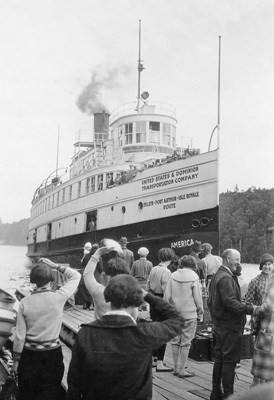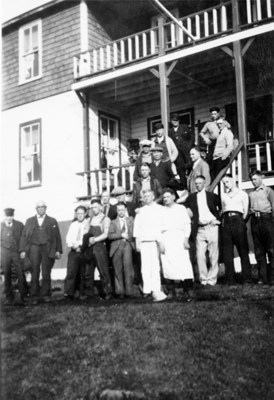Last updated: September 22, 2020
Article
SS America: Operational History

Wolbrink Collection
Operational History
Little historical documentation has been located for the first two seasons of America's operation, other than the ship was periodically chartered for special cruises and to augment the vessels of other lines. One of the early charters was to the International Navigation Co. of New York to run between Buffalo and Niagara Falls (Benton Harbor Daily Palladium, March 12, 1901; Holland City News, March 15, 1901).
America's involvement with Isle Royale began in March 1902 when the Booth Steamship Line purchased the new ship. Booth put America on "the Duluth Port Arthur, and Isle Royale route" (Canadian Railway and Marine World, March 1902:109). Before heading up the Lakes, the ship was altered at Grand Haven where the cabin capacity was "materially increased" (Duluth News Tribune, March 18, 1902). The new Booth Line steamer, due to arrive in Duluth April 15, was rated "one of the finest and fastest freight and passenger boats available" (Ibid., April 5, 1902).
At the end of the 1903 season, the Isle Royale lightkeepers were returned to the mainland aboard America, as they frequently were in the years that followed (Ibid., Nov. 26, 1903). America often had the distinction of being the first passenger out and the last to end the navigation season (e.g. Duluth Evening Herald, April 20, 1914; Duluth News Tribune, April 24, 1918).
For most of America's career it served as a prime communication and transportation link between the Lake Superior north shore settlements and between the mainland and Isle Royale. Passengers and freight were connected to the main economic outlet of the port of Duluth, and this trade was the commercial mainstay of America's operation. In the early period of America's operation the north shore roads were poor (e.g. Duluth Evening Herald, April 22, 1907). America was also a principal summer mail carrier alternating with a stage line that carried during the winter (Duluth Evening Herald, April 30, 1913). Over the course of the last two decades of America's operation, land transportation along the north shore improved markedly, cutting sharply into the steamer's prime role in communications and transportation. A road was completed around Lake Superior in 1921 (Duluth News Tribune, May 1, 1921). During the later years America expanded operations in the excursion trade, although it never left the north shore-Isle Royale run.

R.E. Johns Collection
In 1909 the old company was dissolved and a new enterprise named Booth Fisheries Company of Delaware was formed, that took over the operations (Duluth Evening Herald, June 3, 1909). America had not been affected and was continuing on schedule. A month later Fourth of July celebrations were celebrated at Isle Royale (Ibid., July 10, 1908). The managing agent of America was changed in 1914 to the United States 8t Dominion Transportation Co., a company formed by the Booth Fisheries Co. (Duluth Evening Herald, April 22, 1914). Ownership of the vessel was unchanged.
The start of America's 1911 season was delayed while the hull lengthening was completed (Duluth News Tribune, May 9, 1911). Eighteen feet of length and 12 cabins had been added. The steamer could carry 100 tons more freight as a result of the new alterations. It was announced that the steamer would make three trips a week between Duluth and Port Arthur, and Isle Royale. One of the popular Isle Royale resorts that America frequented was Schofield's Lodge on Belle Isle. It was a popular excursion, and the resort catered to vacation clientele (Duluth Evening Herald, June 17, 1912).
In 1925, the steamer Bruce took over America's operation on the south shore. America would make three trips weekly to Isle Royale and Port Arthur (Duluth News Tribune, April 25, 1925). Later that year, America ran aground at Scott's Point, near Grand Marais and damaged the rudder shoe and stern bearing (Duluth News Tribune, May 30, 31, 1925).
During the last winter of its operation, America steamed to Port Arthur during a severe December storm: The steamer America arrived in port this afternoon from Duluth. She was completely ice-coated. Aboard was a cargo of salt for the Booth Fisheries Canadian company. The vessel is taking back salted herring" (Port Arthur News Chronicle, Dec. 3, 1927). This would have put America on its return voyage to Duluth in the same storm that halted Kamloops, Quedoc, Winnipeg, and other vessels on their upbound journeys from the Sault toward the Canadian Lakehead.
Collisions
Duluth News Tribune, May 5, 1902
America was not in service long before being seriously damaged in a collision with the south pier at the Duluth Ship Canal. "Her bow is bent double and stove in from about 3 feet below the water line to the main deck" and the plates were torn allowing the forward compartment to flood. The accident was attributed to "a good rate of speed" and a crew unacquainted with the current in the canal. The ship was drydocked for repairs (Duluth News Tribune May 5, 1902).
Duluth News Tribune, July 1904
In July 1904, the steamer Holmes' anchor destroyed 5 staterooms along the boat deck of America (Duluth News Tribune July 19, 1904). Holmes was not equipped with anchor pockets. The cabin repair was done by carpenters who worked while America proceeded on its regular trips (Ibid. July 22, 1904).
Duluth News Tribune, July 1909
"The steamer America ran aground at Burlington Point on the north shore about 6 o'clock this morning. She released herself after about an hour, arriving in port about 11 o'clock. Her forefoot was slightly damaged" (Duluth Evening Herald July 9, 1909). "... her bow post and several plates are badly broken and twisted. She will be in dry dock several days" (Duluth News Tribune July 19, 1909). "It was found necessary to put in a new stem and replace about 40 feet of her keel. Twelve new plates are being put in which were bent or broken in the accident and seven frames (Ibid. July 14, 1909).
Duluth News Tribune, May 1914
America was severely damaged when it ran aground a mile northeast of Two Harbors, Minnesota in early May 1914. It was positioned about 100 feet from General O.M. Poe. Five years earlier the two ships had been aground together in virtually the same spot (Duluth News Tribune May 6, 1914). America was positioned broadside to the waves and was punctured below the boilers (Ibid. May 7, 1914). The stranded vessel was lightered and freed on the night of May 7. Necessary repairs were described as "nine plates will be removed and straightened ... and about five feet of her keel will be relaid. The hull was quite badly damaged beneath her engines" (Ibid. May 12, 1914).
Port Arthur News Chronicle, September 1926
A collision between America and Huronic occurred in 1926. The vessels were maneuvering in dense fog near the entrance to the Kaministiquia River. Captain Smith was at the wheel of America when he saw Huronic loom up out of the fog. He quickly turned the wheel and his ship received a glancing blow and slight damage rather than the full brunt of the impact of the other larger steamer (Port Arthur News Chronicle Sept. 13, 1926; Duluth News Tribune Sept. 14, 1926).
Detroit Free Press, July 1927
In mid-summer of 1927 America was involved in a bizarre series of events at Thunder Bay Harbor. On Thursday, July 21,1927, America was headed toward the Booth dock in Port Arthur when a mix-up in the engine room caused it to ram the tug Violet G berthed at the Booth dock, shearing off 15 feet of the tug's stern and tearing away some 20 feet of the dock. There were three crewmen aboard the Violet G at the time; they escaped uninjured. Moments later, America was aground on the rocks at the head of the dock, requiring assistance to be released. Then it collided with, and nearly capsized, the tug Con Lynch that had just freed it. During all this, a lighthouse keeper's gas launch was also slightly damaged. America was reported to be carrying "passengers and a cargo of fruit and package freight" at the time (Detroit Free Press July 23, 1927).
